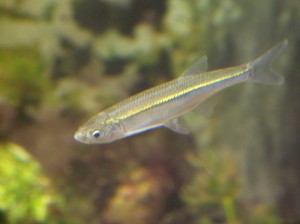 One of the most common and numerous fish, it enjoys popularity despite the size of 10-20 cm. The coloration is pelagic: grayish blue back with a greenish tinge, and silvery flanks and belly with a bright shine. The fins are commonly gray. It is found in Europe, from the White Sea in the north to Caucasus in the south. It is multitudinous in rivers, lakes and reservoirs. In lakes it mainly feeds on the plankton it catches with the upward mouth. Lake bleaks are larger and wider compared to the river ones. The river diet is more diverse. The young stick to bays and thickets, feeding on algae, insect larvae and terrestrial insects falling in. The larger ones remain in mid-water grasping everything the water carries. Apart from plankton and insect larvae, in various seasons they capture pollen, glochidia – mollusk larvae, and terrestrial and flying insects. And when dayfly-ephemera take to air, bleaks turn to feed on them, and the daily nutrition schedule coincides with the flight schedule of the dayflies. Quite possible it is this omnivory that ensure the high numbers of bleaks in rivers and some easy catch for inexperienced fishermen. Bleaks spawn intermittently from May to early July; females lay eggs onto aquatic plants. Bleaks start breeding when 3 years old, with life expectancy of 5-6 years. Bleak scales used to be the source for pearl paste needed to produce faux pearls, but presently aluminum wastage is used for that.
One of the most common and numerous fish, it enjoys popularity despite the size of 10-20 cm. The coloration is pelagic: grayish blue back with a greenish tinge, and silvery flanks and belly with a bright shine. The fins are commonly gray. It is found in Europe, from the White Sea in the north to Caucasus in the south. It is multitudinous in rivers, lakes and reservoirs. In lakes it mainly feeds on the plankton it catches with the upward mouth. Lake bleaks are larger and wider compared to the river ones. The river diet is more diverse. The young stick to bays and thickets, feeding on algae, insect larvae and terrestrial insects falling in. The larger ones remain in mid-water grasping everything the water carries. Apart from plankton and insect larvae, in various seasons they capture pollen, glochidia – mollusk larvae, and terrestrial and flying insects. And when dayfly-ephemera take to air, bleaks turn to feed on them, and the daily nutrition schedule coincides with the flight schedule of the dayflies. Quite possible it is this omnivory that ensure the high numbers of bleaks in rivers and some easy catch for inexperienced fishermen. Bleaks spawn intermittently from May to early July; females lay eggs onto aquatic plants. Bleaks start breeding when 3 years old, with life expectancy of 5-6 years. Bleak scales used to be the source for pearl paste needed to produce faux pearls, but presently aluminum wastage is used for that.
/ * The photos at lake.peipsi.org are cross-posted from commons.wikimedia.org and are used for familiarization purposes only. No commercial use of the photos is allowed. For more information about to use the photos see the originals on commons.wikimedia.org. /


